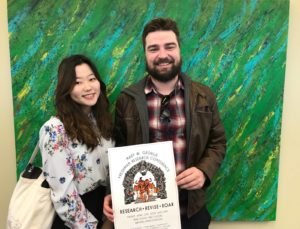Research does not end at simply conducting experiments or making a mind-blowing discovery in your academic field. It’s just as important—or perhaps even more so—to share your findings with others and to hear their thoughts on what you’ve discovered. Throughout your time at Princeton, you will come across multiple opportunities to present your research–whether it’s presenting at Princeton Research Day, drafting independent work proposals for advisors, showcasing your research from summer internships, or even just preparing presentations for class. Sharing your research is thus a common and necessary step in creating scholarly conversation, and can be a very rewarding and enlightening experience for you and for others. However, it can be challenging to find the most effective way to convey your knowledge and work to your audience.
This past April, I participated in the Mary W. George Freshman Research Conference, where I presented my paper “Racism in K-pop: A Reflection of South Korea’s Racialized Discourse of Beauty.” My paper was 16 pages long, and in the beginning, I had no idea how I would synthesize this into a 10-minute presentation. How do you condense a paper that long into just 10 minutes without losing the key points of your argument? Everything in my essay felt critical to my thesis, and yet I knew I couldn’t include every single point in my presentation.
Here are a few aspects that I focused on, which I think will be helpful in transforming your paper into a great presentation.
- Orienting. In our writing seminars, we learn how important it is to orient your reader in our essays; this is even more crucial in a presentation. Specifically for the Mary W. George Conference, I had to keep in mind that the audience was generally not just made up of older students and faculty, but also first-years who were going through the writing seminar experience. It was especially important to be very direct in stating my scholarly motive and thesis and to incorporate such writing seminar-specific terms as guiding signposts for the audience. Visual aids are definitely helpful in pointing out transitions so that you do not have to explicitly state everything and give long-winded explanations as you present.
- Focus on keywords. In the process of condensing my paper into a presentation, I learned to focus on key terms and big ideas that were crucial to my thesis. Using visual aids to illustrate and reinforce the key terms is a great way to orient the audience.

- Less repetition. In my paper, I had a roadmap paragraph that explained which articles I would consult to create a rich scholarly conversation, and how I would use and analyze different sources as evidence to support my thesis. Due to time constraints, this is not very realistic or necessary in a presentation. Whereas in my paper I restated my thesis multiple times to connect back to my argument every time I brought up a new point, my presentation was more of me explaining the analysis of different pieces of evidence that led to a specific conclusion. Perhaps you can include a table of contents slide that gives the audience an overview of your presentation—but only if time allows it.
- For analyzing evidence: quality over quantity. In my paper, I focused on several cases of racism in the K-pop industry. However, for my presentation, I realized that I only had time to really delve into one specific case study–one that was the most comprehensive and effectively illustrated the key points of my argument. It is much better to present a close and detailed analysis of one specific case rather than mentioning and simply glossing over several throughout your presentation.
- Save certain points for later. If there are points that would be useful but are not as critical to your argument, set them aside and save them for the Q&A session after your presentation. There’s a likely chance that someone will ask a question where you can incorporate some of these points into your answers, so do not lament cutting them out from your presentation.
So if you’re at a dilemma on how to change your paper into a presentation, try using these steps in the process. Hopefully these are applicable to preparing for any research conference!
For more advice on presenting your research, you can check out these past posts by Alec, Ellie, and Emma. You can also go here to find out more about the upcoming Mary W. George Conference, which will take place on November 22, 2019.
–Soo Young Yun, Humanities Correspondent

